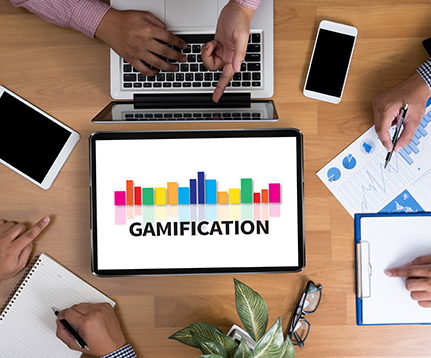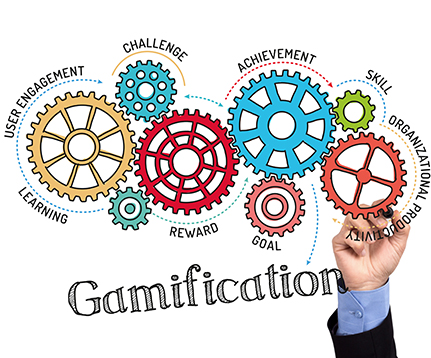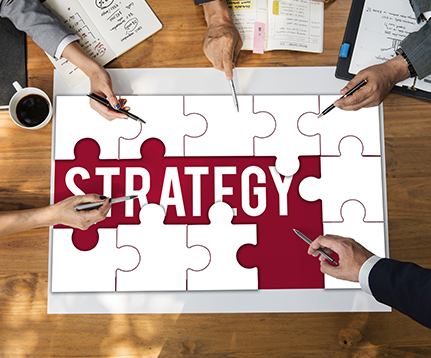|

Gamification in Business: An Introduction
Making the customers engage with a brand is a challenge that very business faces with, in this increasingly competitive world. Businesses are looking for innovative ways to increase the participation and user engagement that drives business value. Customer participation and user engagement build a much more immersive, personalized and long lasting relationship that helps businesses optimize their products or services as per the customer expectations. Wikipedia defines Gamification as ‘the application of game-design elements and game principles in non-game contexts. Gamification commonly employs game design elements which are used in so called non-game contexts in attempts to improve user engagement, organizational productivity, flow, learning, crowdsourcing, employee recruitment and evaluation, ease of use and usefulness of systems, physical exercise, traffic violations, and voter apathy, among others. It takes the essence of fun element of games with a blend of factors like transparency, play and challenge and incorporates it to business objectives for driving more engagement and productivity. A report from ‘MarketsandMarkets’ released in 2016, forecasts that the global gamification market to grow from USD 1.65 billion in 2015 to USD 11.10 billion by2020, at a CAGR of 46.3%.The speedy growth of social media is driving the gamification market.
Gamification is currently being utilized in most of the industries for increasing the customer engagement, learning and personal development, health and wellness management, employee performance, innovation management and so on.
|
|

Key Benefits of Implementing Gamification in Business
Gamification is a proven method for engaging people, developing skills, solving problems and motivating them for accepting changes. Let us have a look at the key benefits of implementing gamification in business.
Improved Performance: Gamification helps in driving continuous engagement, collaboration and improving business performance. Most gamification platforms allow organizations to collect a vast amount of customer data which will be mostly associated with clicks, achievements, points, rewards and customer interests. This will provide valuable customer insights and information that can help in optimizing the overall business performance.
Competition: Gamification drives healthy competition among the participants and fosters innovation which helps in driving business success. Participants can share their achievements, compare their performance with the others through the milestones, points, leader boards and ranking systems which acts as a major motivational factor to sustain engagement.
Productivity: Gamification with badges of appreciation enhances the productivity drastically. It motivates people to track their performance and push themselves for a better performance. User behavior can be tracked in real time and can be used to make better future strategies.
Engagement: Gamification increases the customer engagement and initiates realistic interactions which prompt the customer to come back to the brand for more. The fun element in gamification prompts people to participate and engage. This indirectly keeps the brand on top of customers’ mind and they introduce the brand to their family and friends.
Cost Optimization: Gamification can play a key role in the cost optimization measures in organizations. It reduces the training and development costs to a large extent. Gamification is a cost effective way to train, educate and develop the best practices for streamlining the processes and increasing the user participation.
Education: It is a creative way to introduce a new product or service to the customers. Gamification uses design based approach which is very effective in educating customers regarding the products or services. This design based approach creates more focus, long term memory in the customer’s mind and supports better brand recall in their mind.
Rewards & Recognition: Gamification improves the effectiveness of reward and recognition programs. It drives people to complete an action and by rewards, they will get a sense of satisfaction and achievement.
|
|

The Four Key Principles of an Effective Gamification Strategy
Set your business objective
Before implementing any gamification techniques, there should be a clear identification of the business objectives and the gamification design must be aligned with these objectives. In addition to this, a critical assessment of the suitability of the gamification method should be done to achieve the specified business objectives.
Identify your target audience
Identifying the right target audience and designing the gamification techniques to match with their interest is significant for an effective gamification strategy. Keeping the audience in mind is crucial for driving the continuous engagement.
Define and design an appropriate gaming strategy
The strategy must be simple enough for the users to understand and get started immediately. It needs to add a fun element which increases the customer engagement. The rewards should be progressive and fair, which motivates people to achieve something.
Focus on timely feedback
Timely and continuous feedback enables the participants to improve their quality of performance. The presentation of feedback is also important. Feedback with charts, analysis and detailed reports increases the overall impact of the game.
|
Happiest Minds Play in the Field of Gamification
Digital engagement and loyalty solutions from Happiest Minds helps brands “close the loop” with their consumer communication and gamify the experience for consumers by offering loyalty points for every digital interaction. The benefits include structured and sustained interactions with consumers, deep consumer insights, and increased loyalty. The Gamification platform we developed for a leading beverage and lifestyle based MNC has brought in increased the user engagement, improved user insights from the website through analytics and it drove customer engagement and loyalty on the website.
|